LSME403: Google's Organizational Structure and Dynamic Processes
VerifiedAdded on 2022/08/14
|11
|2599
|12
Essay
AI Summary
This essay provides a comprehensive analysis of Google's organizational structure and design, examining the factors that influence its corporate structure. It delves into how Google manages dynamic processes such as organizational culture, ethical values, innovation, and decision-making to shape its growth and evolution. The essay explores the impact of technology, organizational size, skilled manpower, and global presence on Google's structure. It also highlights how Google's culture fosters innovation and ethical practices, and how its decision-making processes contribute to its success. The essay concludes by summarizing the key elements that contribute to Google's organizational effectiveness.
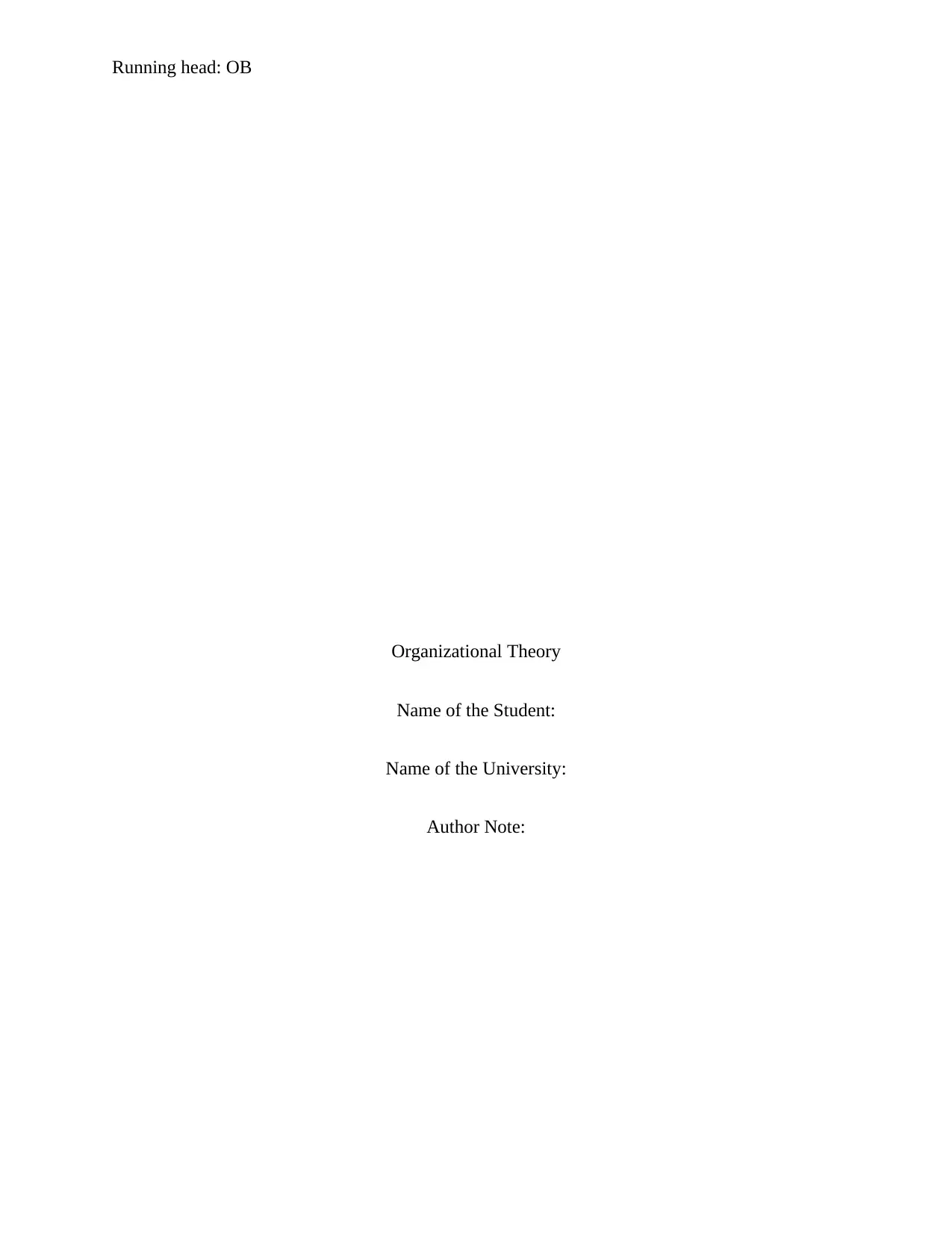
Running head: OB
Organizational Theory
Name of the Student:
Name of the University:
Author Note:
Organizational Theory
Name of the Student:
Name of the University:
Author Note:
Paraphrase This Document
Need a fresh take? Get an instant paraphrase of this document with our AI Paraphraser
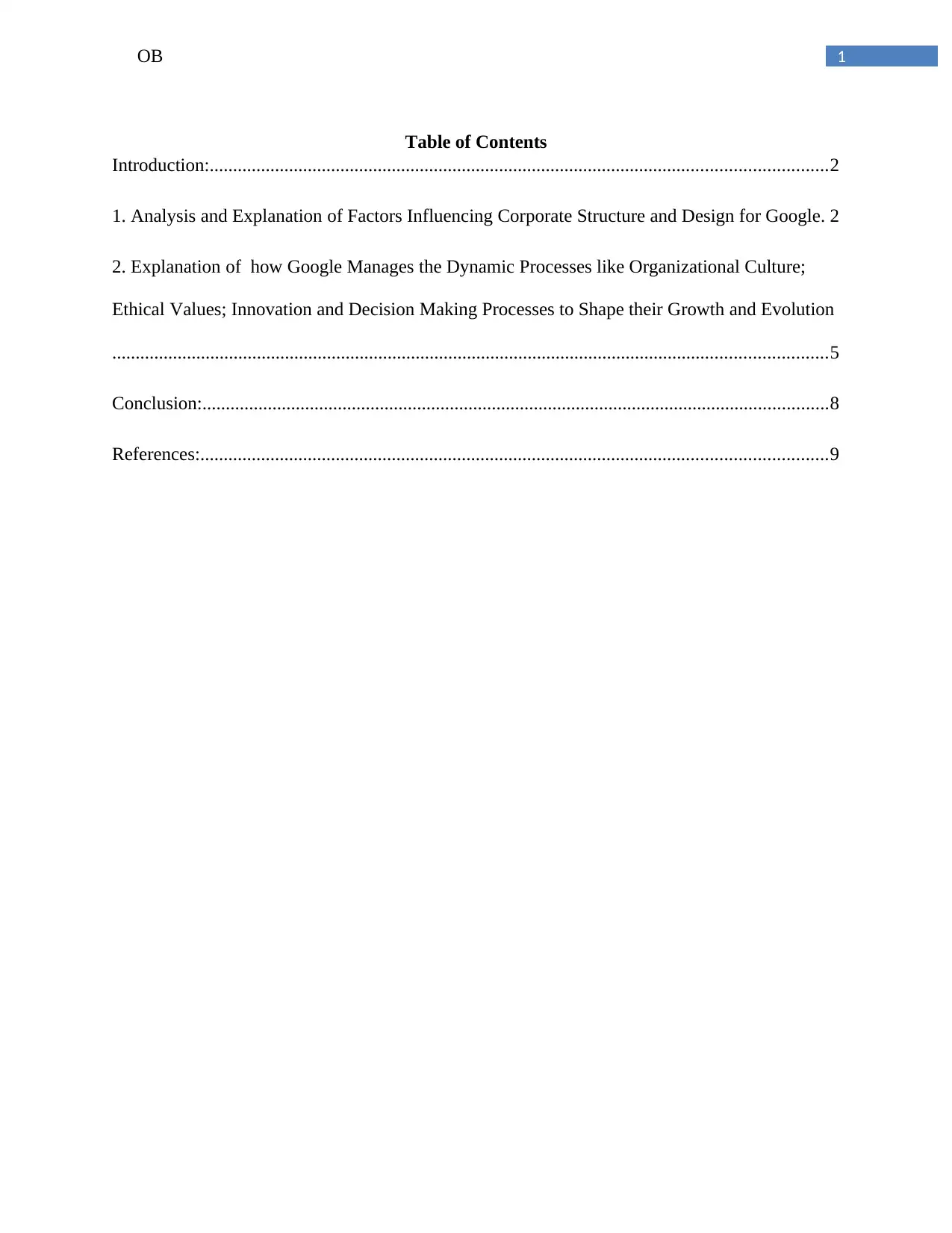
1OB
Table of Contents
Introduction:....................................................................................................................................2
1. Analysis and Explanation of Factors Influencing Corporate Structure and Design for Google. 2
2. Explanation of how Google Manages the Dynamic Processes like Organizational Culture;
Ethical Values; Innovation and Decision Making Processes to Shape their Growth and Evolution
.........................................................................................................................................................5
Conclusion:......................................................................................................................................8
References:......................................................................................................................................9
Table of Contents
Introduction:....................................................................................................................................2
1. Analysis and Explanation of Factors Influencing Corporate Structure and Design for Google. 2
2. Explanation of how Google Manages the Dynamic Processes like Organizational Culture;
Ethical Values; Innovation and Decision Making Processes to Shape their Growth and Evolution
.........................................................................................................................................................5
Conclusion:......................................................................................................................................8
References:......................................................................................................................................9
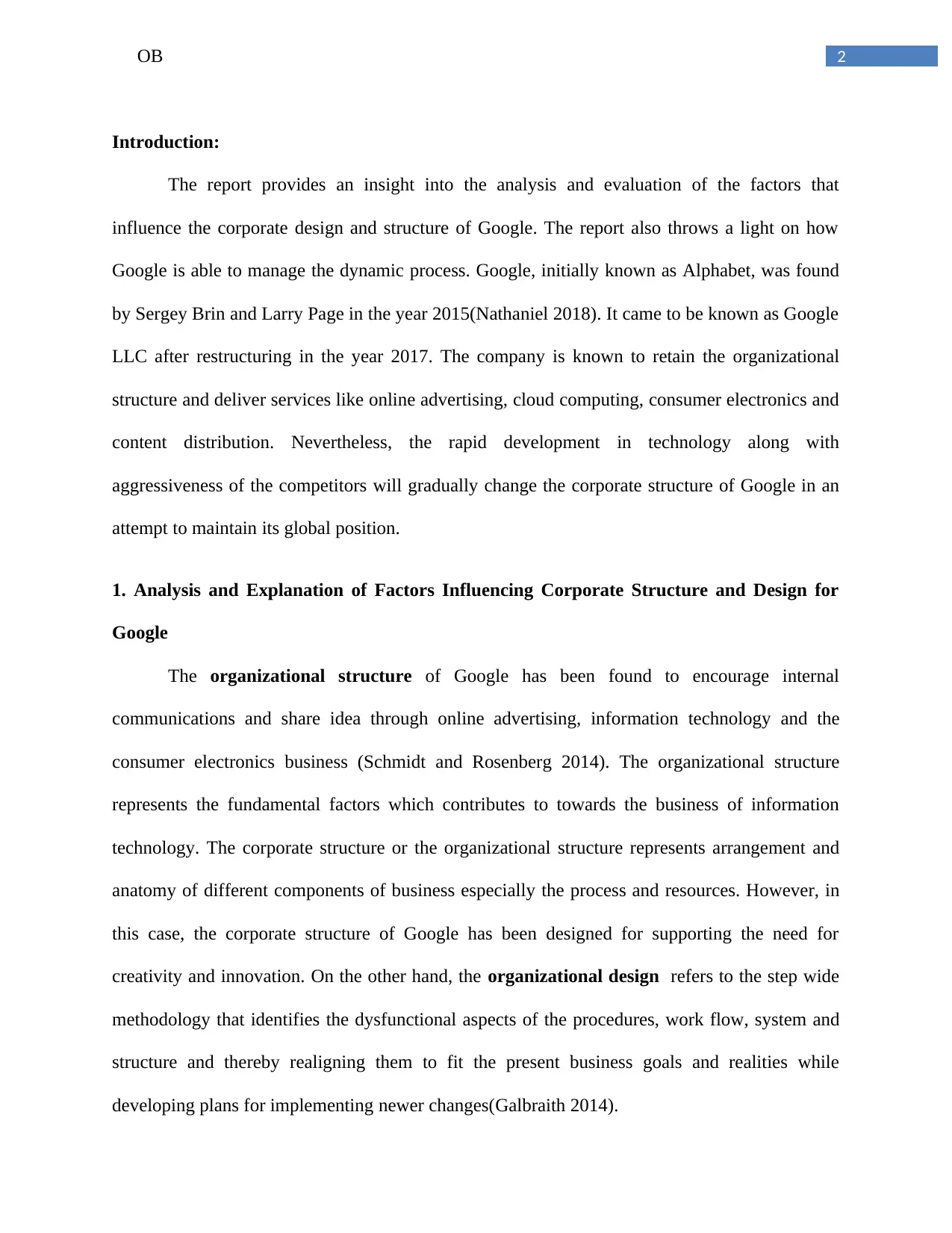
2OB
Introduction:
The report provides an insight into the analysis and evaluation of the factors that
influence the corporate design and structure of Google. The report also throws a light on how
Google is able to manage the dynamic process. Google, initially known as Alphabet, was found
by Sergey Brin and Larry Page in the year 2015(Nathaniel 2018). It came to be known as Google
LLC after restructuring in the year 2017. The company is known to retain the organizational
structure and deliver services like online advertising, cloud computing, consumer electronics and
content distribution. Nevertheless, the rapid development in technology along with
aggressiveness of the competitors will gradually change the corporate structure of Google in an
attempt to maintain its global position.
1. Analysis and Explanation of Factors Influencing Corporate Structure and Design for
Google
The organizational structure of Google has been found to encourage internal
communications and share idea through online advertising, information technology and the
consumer electronics business (Schmidt and Rosenberg 2014). The organizational structure
represents the fundamental factors which contributes to towards the business of information
technology. The corporate structure or the organizational structure represents arrangement and
anatomy of different components of business especially the process and resources. However, in
this case, the corporate structure of Google has been designed for supporting the need for
creativity and innovation. On the other hand, the organizational design refers to the step wide
methodology that identifies the dysfunctional aspects of the procedures, work flow, system and
structure and thereby realigning them to fit the present business goals and realities while
developing plans for implementing newer changes(Galbraith 2014).
Introduction:
The report provides an insight into the analysis and evaluation of the factors that
influence the corporate design and structure of Google. The report also throws a light on how
Google is able to manage the dynamic process. Google, initially known as Alphabet, was found
by Sergey Brin and Larry Page in the year 2015(Nathaniel 2018). It came to be known as Google
LLC after restructuring in the year 2017. The company is known to retain the organizational
structure and deliver services like online advertising, cloud computing, consumer electronics and
content distribution. Nevertheless, the rapid development in technology along with
aggressiveness of the competitors will gradually change the corporate structure of Google in an
attempt to maintain its global position.
1. Analysis and Explanation of Factors Influencing Corporate Structure and Design for
The organizational structure of Google has been found to encourage internal
communications and share idea through online advertising, information technology and the
consumer electronics business (Schmidt and Rosenberg 2014). The organizational structure
represents the fundamental factors which contributes to towards the business of information
technology. The corporate structure or the organizational structure represents arrangement and
anatomy of different components of business especially the process and resources. However, in
this case, the corporate structure of Google has been designed for supporting the need for
creativity and innovation. On the other hand, the organizational design refers to the step wide
methodology that identifies the dysfunctional aspects of the procedures, work flow, system and
structure and thereby realigning them to fit the present business goals and realities while
developing plans for implementing newer changes(Galbraith 2014).
⊘ This is a preview!⊘
Do you want full access?
Subscribe today to unlock all pages.

Trusted by 1+ million students worldwide
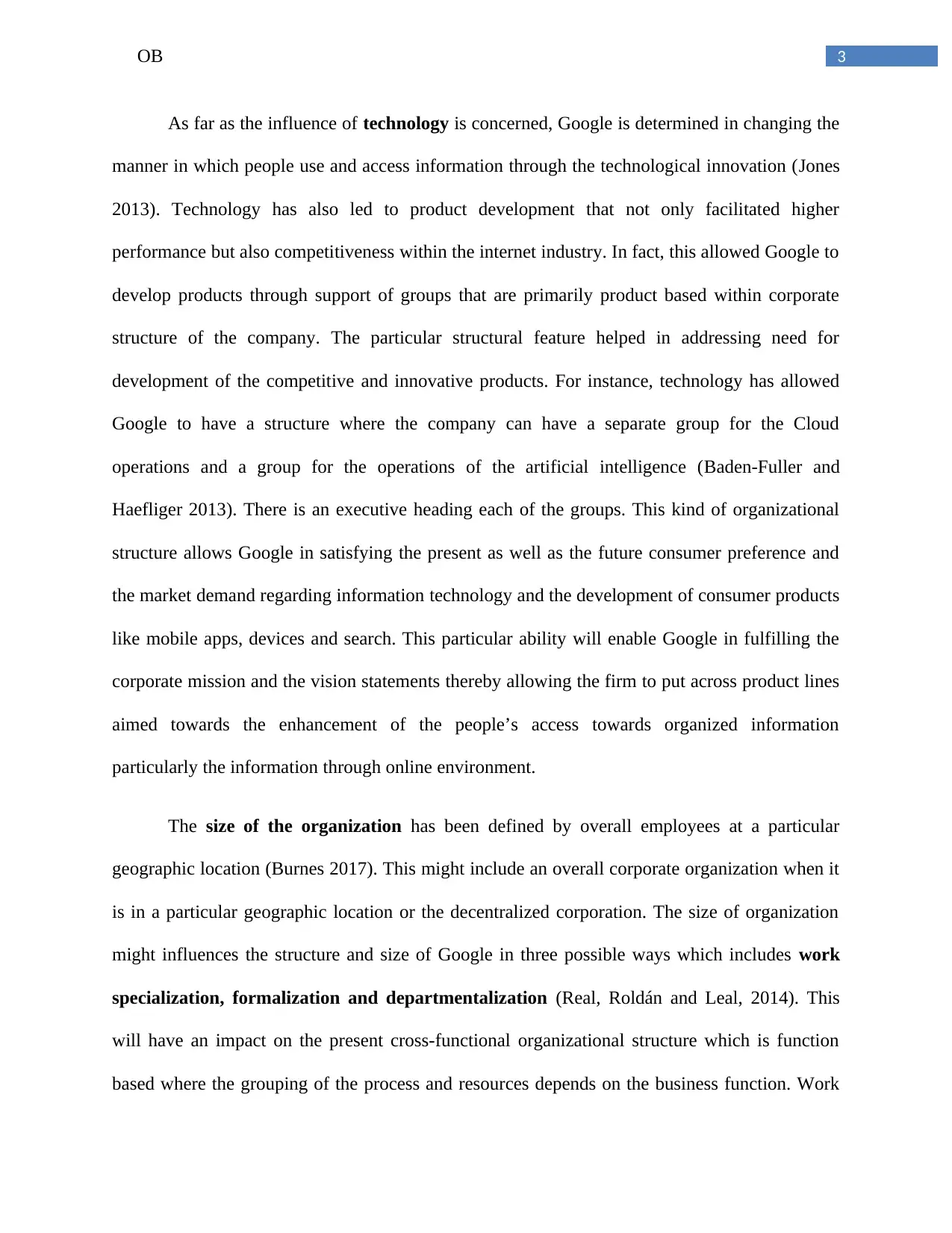
3OB
As far as the influence of technology is concerned, Google is determined in changing the
manner in which people use and access information through the technological innovation (Jones
2013). Technology has also led to product development that not only facilitated higher
performance but also competitiveness within the internet industry. In fact, this allowed Google to
develop products through support of groups that are primarily product based within corporate
structure of the company. The particular structural feature helped in addressing need for
development of the competitive and innovative products. For instance, technology has allowed
Google to have a structure where the company can have a separate group for the Cloud
operations and a group for the operations of the artificial intelligence (Baden-Fuller and
Haefliger 2013). There is an executive heading each of the groups. This kind of organizational
structure allows Google in satisfying the present as well as the future consumer preference and
the market demand regarding information technology and the development of consumer products
like mobile apps, devices and search. This particular ability will enable Google in fulfilling the
corporate mission and the vision statements thereby allowing the firm to put across product lines
aimed towards the enhancement of the people’s access towards organized information
particularly the information through online environment.
The size of the organization has been defined by overall employees at a particular
geographic location (Burnes 2017). This might include an overall corporate organization when it
is in a particular geographic location or the decentralized corporation. The size of organization
might influences the structure and size of Google in three possible ways which includes work
specialization, formalization and departmentalization (Real, Roldán and Leal, 2014). This
will have an impact on the present cross-functional organizational structure which is function
based where the grouping of the process and resources depends on the business function. Work
As far as the influence of technology is concerned, Google is determined in changing the
manner in which people use and access information through the technological innovation (Jones
2013). Technology has also led to product development that not only facilitated higher
performance but also competitiveness within the internet industry. In fact, this allowed Google to
develop products through support of groups that are primarily product based within corporate
structure of the company. The particular structural feature helped in addressing need for
development of the competitive and innovative products. For instance, technology has allowed
Google to have a structure where the company can have a separate group for the Cloud
operations and a group for the operations of the artificial intelligence (Baden-Fuller and
Haefliger 2013). There is an executive heading each of the groups. This kind of organizational
structure allows Google in satisfying the present as well as the future consumer preference and
the market demand regarding information technology and the development of consumer products
like mobile apps, devices and search. This particular ability will enable Google in fulfilling the
corporate mission and the vision statements thereby allowing the firm to put across product lines
aimed towards the enhancement of the people’s access towards organized information
particularly the information through online environment.
The size of the organization has been defined by overall employees at a particular
geographic location (Burnes 2017). This might include an overall corporate organization when it
is in a particular geographic location or the decentralized corporation. The size of organization
might influences the structure and size of Google in three possible ways which includes work
specialization, formalization and departmentalization (Real, Roldán and Leal, 2014). This
will have an impact on the present cross-functional organizational structure which is function
based where the grouping of the process and resources depends on the business function. Work
Paraphrase This Document
Need a fresh take? Get an instant paraphrase of this document with our AI Paraphraser
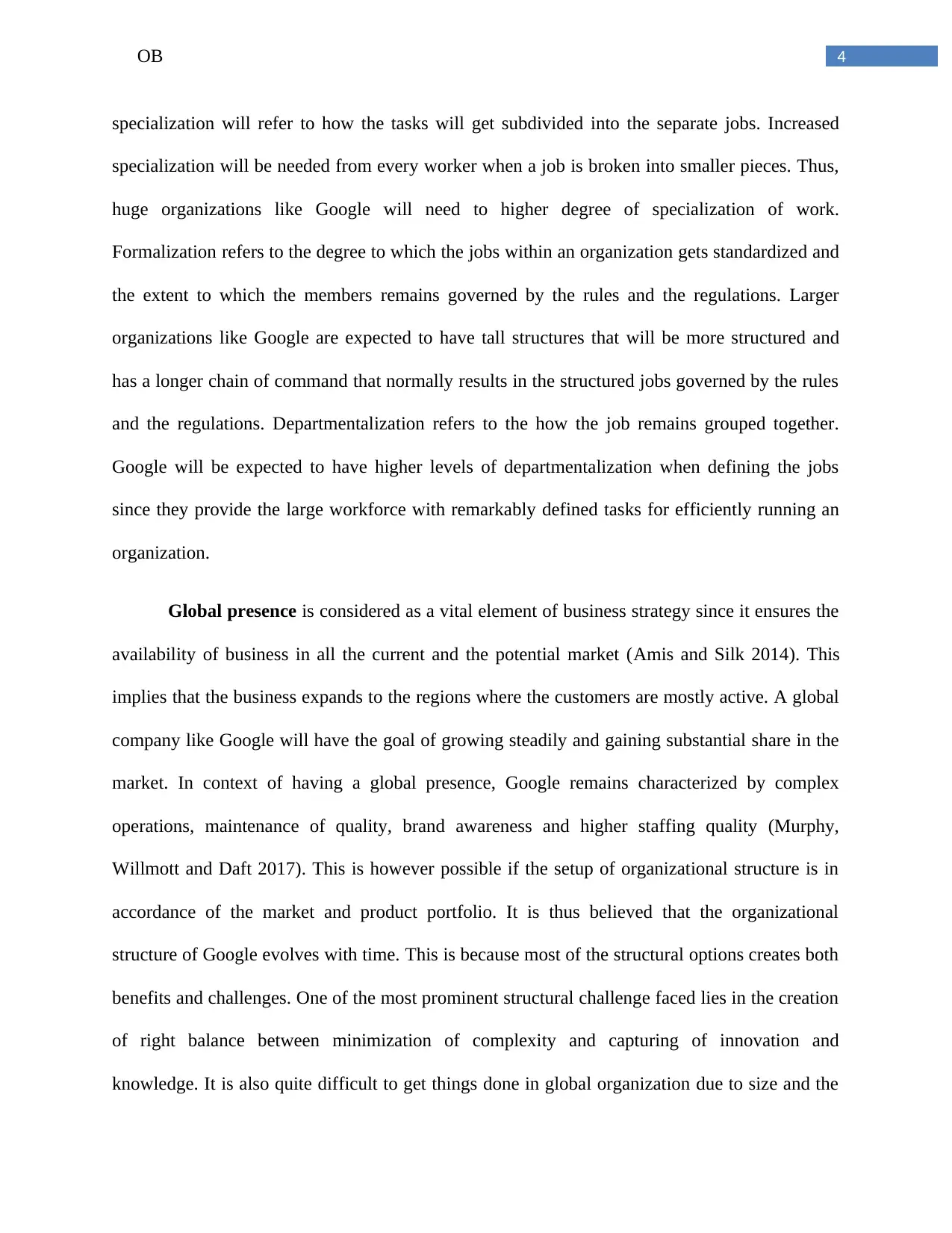
4OB
specialization will refer to how the tasks will get subdivided into the separate jobs. Increased
specialization will be needed from every worker when a job is broken into smaller pieces. Thus,
huge organizations like Google will need to higher degree of specialization of work.
Formalization refers to the degree to which the jobs within an organization gets standardized and
the extent to which the members remains governed by the rules and the regulations. Larger
organizations like Google are expected to have tall structures that will be more structured and
has a longer chain of command that normally results in the structured jobs governed by the rules
and the regulations. Departmentalization refers to the how the job remains grouped together.
Google will be expected to have higher levels of departmentalization when defining the jobs
since they provide the large workforce with remarkably defined tasks for efficiently running an
organization.
Global presence is considered as a vital element of business strategy since it ensures the
availability of business in all the current and the potential market (Amis and Silk 2014). This
implies that the business expands to the regions where the customers are mostly active. A global
company like Google will have the goal of growing steadily and gaining substantial share in the
market. In context of having a global presence, Google remains characterized by complex
operations, maintenance of quality, brand awareness and higher staffing quality (Murphy,
Willmott and Daft 2017). This is however possible if the setup of organizational structure is in
accordance of the market and product portfolio. It is thus believed that the organizational
structure of Google evolves with time. This is because most of the structural options creates both
benefits and challenges. One of the most prominent structural challenge faced lies in the creation
of right balance between minimization of complexity and capturing of innovation and
knowledge. It is also quite difficult to get things done in global organization due to size and the
specialization will refer to how the tasks will get subdivided into the separate jobs. Increased
specialization will be needed from every worker when a job is broken into smaller pieces. Thus,
huge organizations like Google will need to higher degree of specialization of work.
Formalization refers to the degree to which the jobs within an organization gets standardized and
the extent to which the members remains governed by the rules and the regulations. Larger
organizations like Google are expected to have tall structures that will be more structured and
has a longer chain of command that normally results in the structured jobs governed by the rules
and the regulations. Departmentalization refers to the how the job remains grouped together.
Google will be expected to have higher levels of departmentalization when defining the jobs
since they provide the large workforce with remarkably defined tasks for efficiently running an
organization.
Global presence is considered as a vital element of business strategy since it ensures the
availability of business in all the current and the potential market (Amis and Silk 2014). This
implies that the business expands to the regions where the customers are mostly active. A global
company like Google will have the goal of growing steadily and gaining substantial share in the
market. In context of having a global presence, Google remains characterized by complex
operations, maintenance of quality, brand awareness and higher staffing quality (Murphy,
Willmott and Daft 2017). This is however possible if the setup of organizational structure is in
accordance of the market and product portfolio. It is thus believed that the organizational
structure of Google evolves with time. This is because most of the structural options creates both
benefits and challenges. One of the most prominent structural challenge faced lies in the creation
of right balance between minimization of complexity and capturing of innovation and
knowledge. It is also quite difficult to get things done in global organization due to size and the
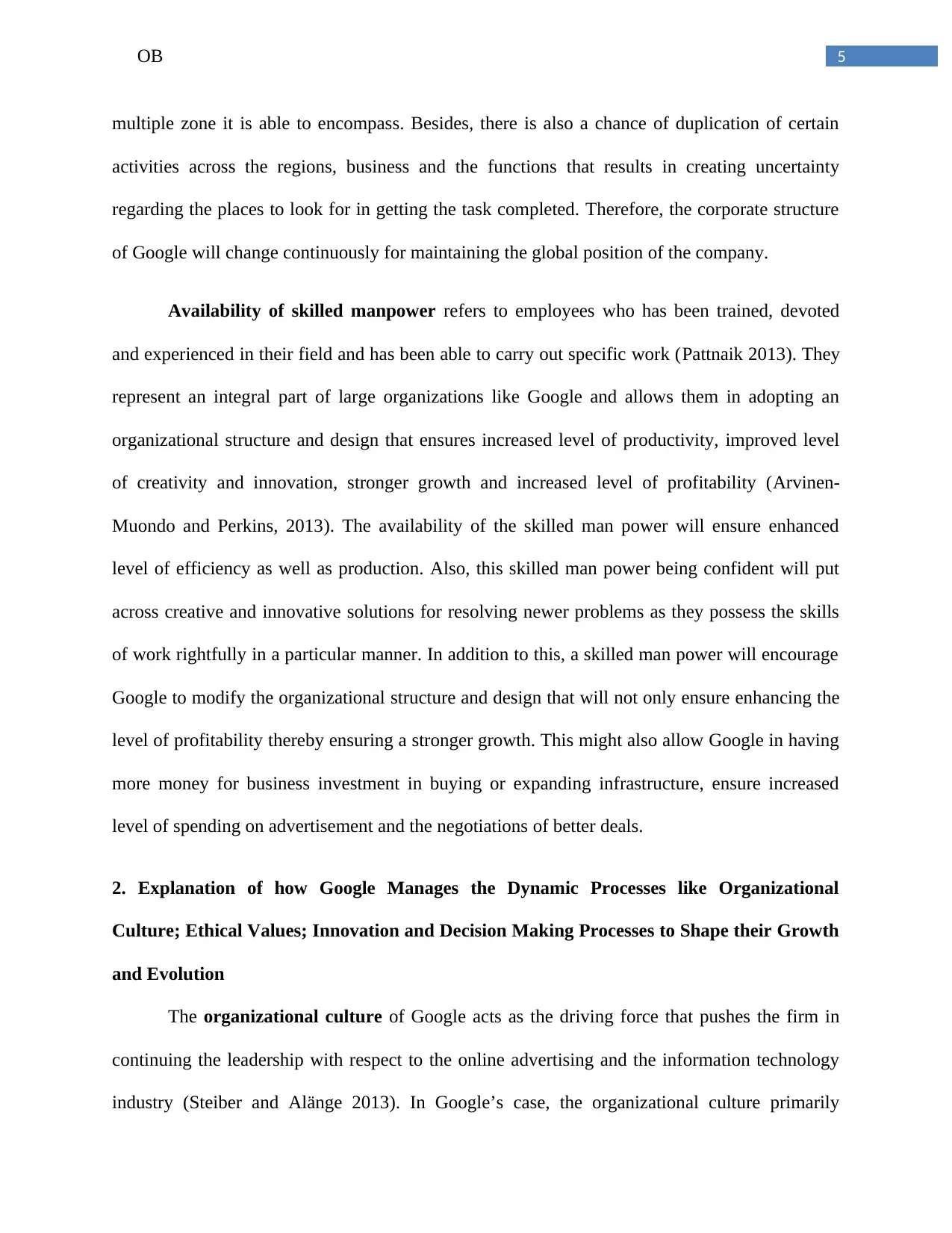
5OB
multiple zone it is able to encompass. Besides, there is also a chance of duplication of certain
activities across the regions, business and the functions that results in creating uncertainty
regarding the places to look for in getting the task completed. Therefore, the corporate structure
of Google will change continuously for maintaining the global position of the company.
Availability of skilled manpower refers to employees who has been trained, devoted
and experienced in their field and has been able to carry out specific work (Pattnaik 2013). They
represent an integral part of large organizations like Google and allows them in adopting an
organizational structure and design that ensures increased level of productivity, improved level
of creativity and innovation, stronger growth and increased level of profitability (Arvinen-
Muondo and Perkins, 2013). The availability of the skilled man power will ensure enhanced
level of efficiency as well as production. Also, this skilled man power being confident will put
across creative and innovative solutions for resolving newer problems as they possess the skills
of work rightfully in a particular manner. In addition to this, a skilled man power will encourage
Google to modify the organizational structure and design that will not only ensure enhancing the
level of profitability thereby ensuring a stronger growth. This might also allow Google in having
more money for business investment in buying or expanding infrastructure, ensure increased
level of spending on advertisement and the negotiations of better deals.
2. Explanation of how Google Manages the Dynamic Processes like Organizational
Culture; Ethical Values; Innovation and Decision Making Processes to Shape their Growth
and Evolution
The organizational culture of Google acts as the driving force that pushes the firm in
continuing the leadership with respect to the online advertising and the information technology
industry (Steiber and Alänge 2013). In Google’s case, the organizational culture primarily
multiple zone it is able to encompass. Besides, there is also a chance of duplication of certain
activities across the regions, business and the functions that results in creating uncertainty
regarding the places to look for in getting the task completed. Therefore, the corporate structure
of Google will change continuously for maintaining the global position of the company.
Availability of skilled manpower refers to employees who has been trained, devoted
and experienced in their field and has been able to carry out specific work (Pattnaik 2013). They
represent an integral part of large organizations like Google and allows them in adopting an
organizational structure and design that ensures increased level of productivity, improved level
of creativity and innovation, stronger growth and increased level of profitability (Arvinen-
Muondo and Perkins, 2013). The availability of the skilled man power will ensure enhanced
level of efficiency as well as production. Also, this skilled man power being confident will put
across creative and innovative solutions for resolving newer problems as they possess the skills
of work rightfully in a particular manner. In addition to this, a skilled man power will encourage
Google to modify the organizational structure and design that will not only ensure enhancing the
level of profitability thereby ensuring a stronger growth. This might also allow Google in having
more money for business investment in buying or expanding infrastructure, ensure increased
level of spending on advertisement and the negotiations of better deals.
2. Explanation of how Google Manages the Dynamic Processes like Organizational
Culture; Ethical Values; Innovation and Decision Making Processes to Shape their Growth
and Evolution
The organizational culture of Google acts as the driving force that pushes the firm in
continuing the leadership with respect to the online advertising and the information technology
industry (Steiber and Alänge 2013). In Google’s case, the organizational culture primarily
⊘ This is a preview!⊘
Do you want full access?
Subscribe today to unlock all pages.

Trusted by 1+ million students worldwide
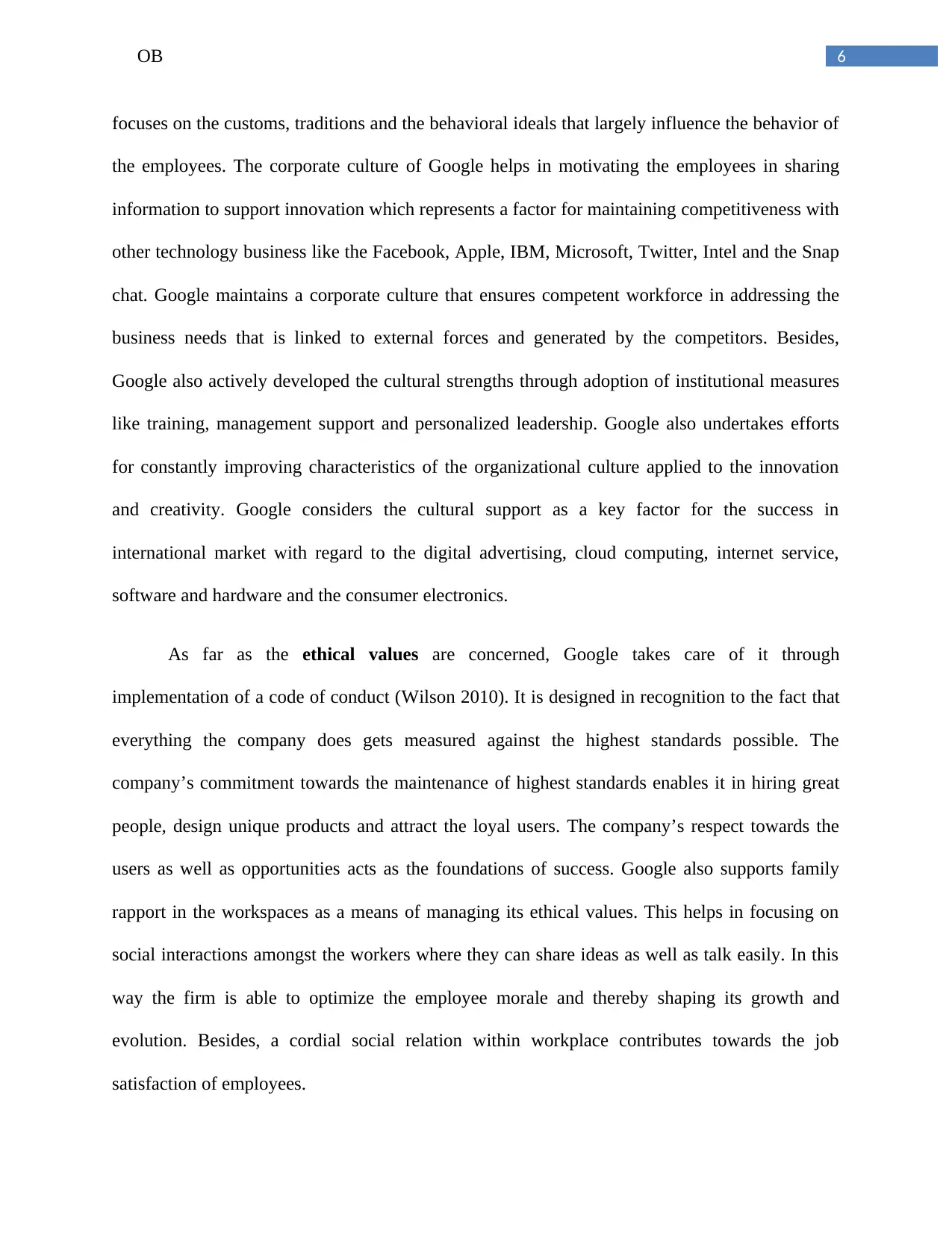
6OB
focuses on the customs, traditions and the behavioral ideals that largely influence the behavior of
the employees. The corporate culture of Google helps in motivating the employees in sharing
information to support innovation which represents a factor for maintaining competitiveness with
other technology business like the Facebook, Apple, IBM, Microsoft, Twitter, Intel and the Snap
chat. Google maintains a corporate culture that ensures competent workforce in addressing the
business needs that is linked to external forces and generated by the competitors. Besides,
Google also actively developed the cultural strengths through adoption of institutional measures
like training, management support and personalized leadership. Google also undertakes efforts
for constantly improving characteristics of the organizational culture applied to the innovation
and creativity. Google considers the cultural support as a key factor for the success in
international market with regard to the digital advertising, cloud computing, internet service,
software and hardware and the consumer electronics.
As far as the ethical values are concerned, Google takes care of it through
implementation of a code of conduct (Wilson 2010). It is designed in recognition to the fact that
everything the company does gets measured against the highest standards possible. The
company’s commitment towards the maintenance of highest standards enables it in hiring great
people, design unique products and attract the loyal users. The company’s respect towards the
users as well as opportunities acts as the foundations of success. Google also supports family
rapport in the workspaces as a means of managing its ethical values. This helps in focusing on
social interactions amongst the workers where they can share ideas as well as talk easily. In this
way the firm is able to optimize the employee morale and thereby shaping its growth and
evolution. Besides, a cordial social relation within workplace contributes towards the job
satisfaction of employees.
focuses on the customs, traditions and the behavioral ideals that largely influence the behavior of
the employees. The corporate culture of Google helps in motivating the employees in sharing
information to support innovation which represents a factor for maintaining competitiveness with
other technology business like the Facebook, Apple, IBM, Microsoft, Twitter, Intel and the Snap
chat. Google maintains a corporate culture that ensures competent workforce in addressing the
business needs that is linked to external forces and generated by the competitors. Besides,
Google also actively developed the cultural strengths through adoption of institutional measures
like training, management support and personalized leadership. Google also undertakes efforts
for constantly improving characteristics of the organizational culture applied to the innovation
and creativity. Google considers the cultural support as a key factor for the success in
international market with regard to the digital advertising, cloud computing, internet service,
software and hardware and the consumer electronics.
As far as the ethical values are concerned, Google takes care of it through
implementation of a code of conduct (Wilson 2010). It is designed in recognition to the fact that
everything the company does gets measured against the highest standards possible. The
company’s commitment towards the maintenance of highest standards enables it in hiring great
people, design unique products and attract the loyal users. The company’s respect towards the
users as well as opportunities acts as the foundations of success. Google also supports family
rapport in the workspaces as a means of managing its ethical values. This helps in focusing on
social interactions amongst the workers where they can share ideas as well as talk easily. In this
way the firm is able to optimize the employee morale and thereby shaping its growth and
evolution. Besides, a cordial social relation within workplace contributes towards the job
satisfaction of employees.
Paraphrase This Document
Need a fresh take? Get an instant paraphrase of this document with our AI Paraphraser
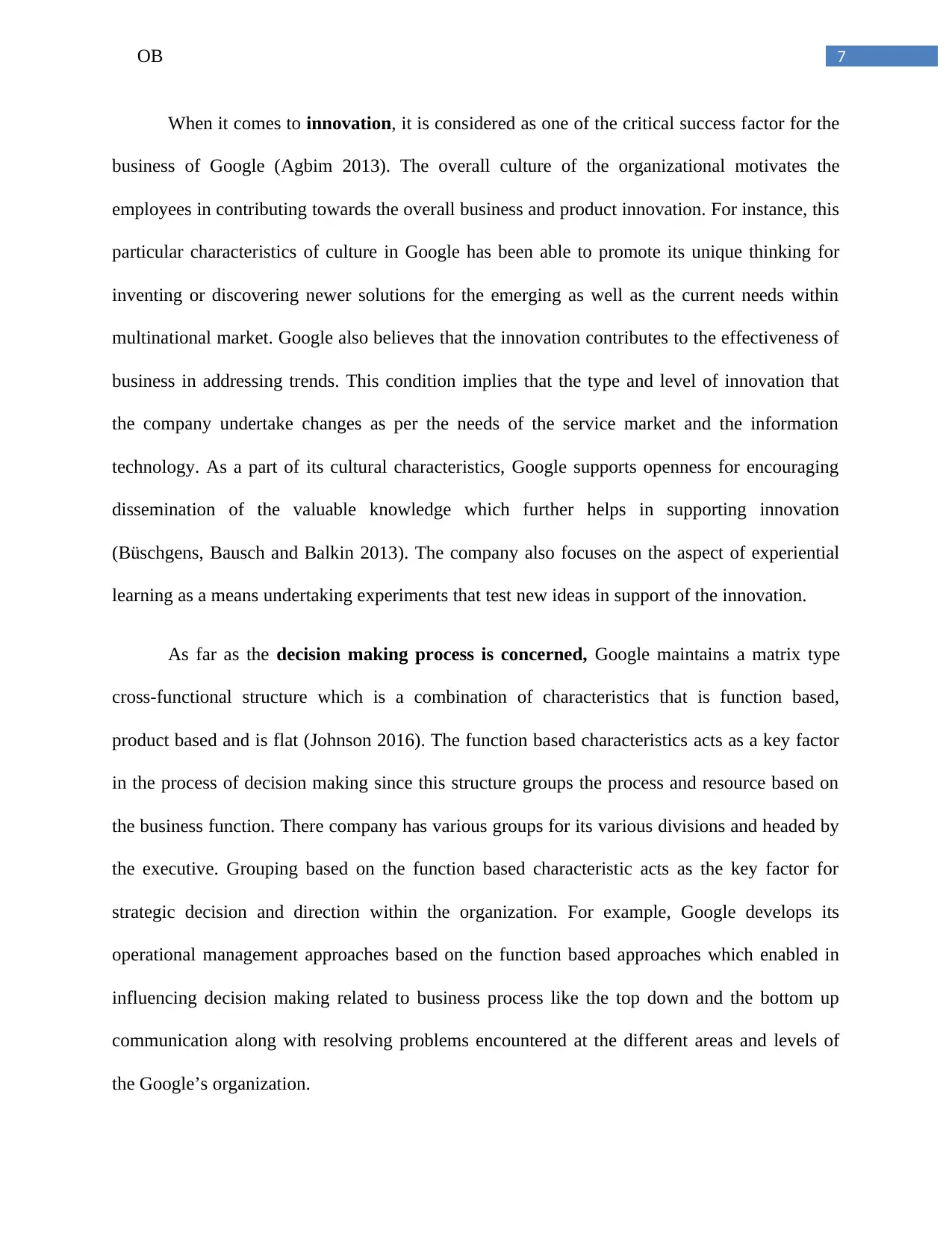
7OB
When it comes to innovation, it is considered as one of the critical success factor for the
business of Google (Agbim 2013). The overall culture of the organizational motivates the
employees in contributing towards the overall business and product innovation. For instance, this
particular characteristics of culture in Google has been able to promote its unique thinking for
inventing or discovering newer solutions for the emerging as well as the current needs within
multinational market. Google also believes that the innovation contributes to the effectiveness of
business in addressing trends. This condition implies that the type and level of innovation that
the company undertake changes as per the needs of the service market and the information
technology. As a part of its cultural characteristics, Google supports openness for encouraging
dissemination of the valuable knowledge which further helps in supporting innovation
(Büschgens, Bausch and Balkin 2013). The company also focuses on the aspect of experiential
learning as a means undertaking experiments that test new ideas in support of the innovation.
As far as the decision making process is concerned, Google maintains a matrix type
cross-functional structure which is a combination of characteristics that is function based,
product based and is flat (Johnson 2016). The function based characteristics acts as a key factor
in the process of decision making since this structure groups the process and resource based on
the business function. There company has various groups for its various divisions and headed by
the executive. Grouping based on the function based characteristic acts as the key factor for
strategic decision and direction within the organization. For example, Google develops its
operational management approaches based on the function based approaches which enabled in
influencing decision making related to business process like the top down and the bottom up
communication along with resolving problems encountered at the different areas and levels of
the Google’s organization.
When it comes to innovation, it is considered as one of the critical success factor for the
business of Google (Agbim 2013). The overall culture of the organizational motivates the
employees in contributing towards the overall business and product innovation. For instance, this
particular characteristics of culture in Google has been able to promote its unique thinking for
inventing or discovering newer solutions for the emerging as well as the current needs within
multinational market. Google also believes that the innovation contributes to the effectiveness of
business in addressing trends. This condition implies that the type and level of innovation that
the company undertake changes as per the needs of the service market and the information
technology. As a part of its cultural characteristics, Google supports openness for encouraging
dissemination of the valuable knowledge which further helps in supporting innovation
(Büschgens, Bausch and Balkin 2013). The company also focuses on the aspect of experiential
learning as a means undertaking experiments that test new ideas in support of the innovation.
As far as the decision making process is concerned, Google maintains a matrix type
cross-functional structure which is a combination of characteristics that is function based,
product based and is flat (Johnson 2016). The function based characteristics acts as a key factor
in the process of decision making since this structure groups the process and resource based on
the business function. There company has various groups for its various divisions and headed by
the executive. Grouping based on the function based characteristic acts as the key factor for
strategic decision and direction within the organization. For example, Google develops its
operational management approaches based on the function based approaches which enabled in
influencing decision making related to business process like the top down and the bottom up
communication along with resolving problems encountered at the different areas and levels of
the Google’s organization.
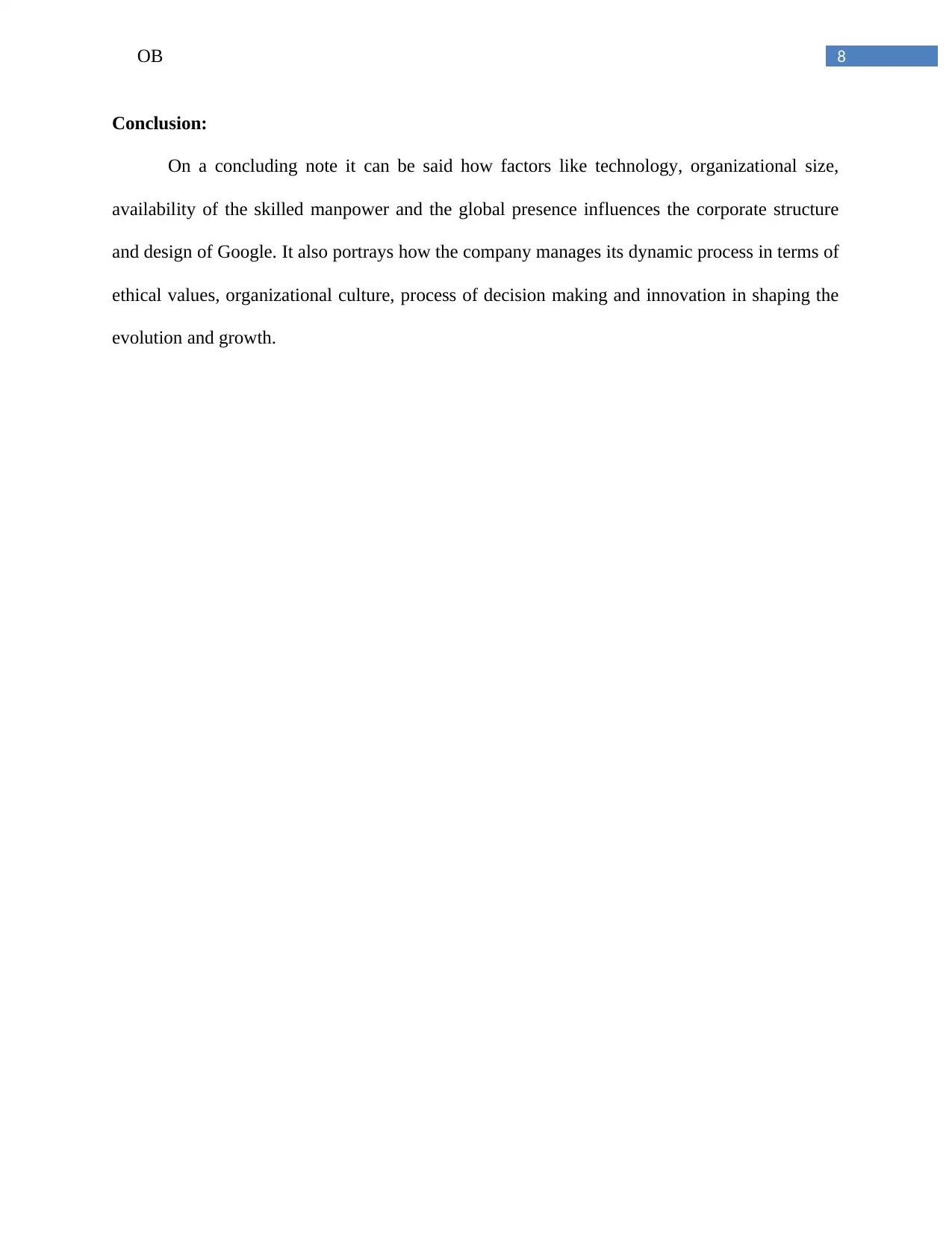
8OB
Conclusion:
On a concluding note it can be said how factors like technology, organizational size,
availability of the skilled manpower and the global presence influences the corporate structure
and design of Google. It also portrays how the company manages its dynamic process in terms of
ethical values, organizational culture, process of decision making and innovation in shaping the
evolution and growth.
Conclusion:
On a concluding note it can be said how factors like technology, organizational size,
availability of the skilled manpower and the global presence influences the corporate structure
and design of Google. It also portrays how the company manages its dynamic process in terms of
ethical values, organizational culture, process of decision making and innovation in shaping the
evolution and growth.
⊘ This is a preview!⊘
Do you want full access?
Subscribe today to unlock all pages.

Trusted by 1+ million students worldwide
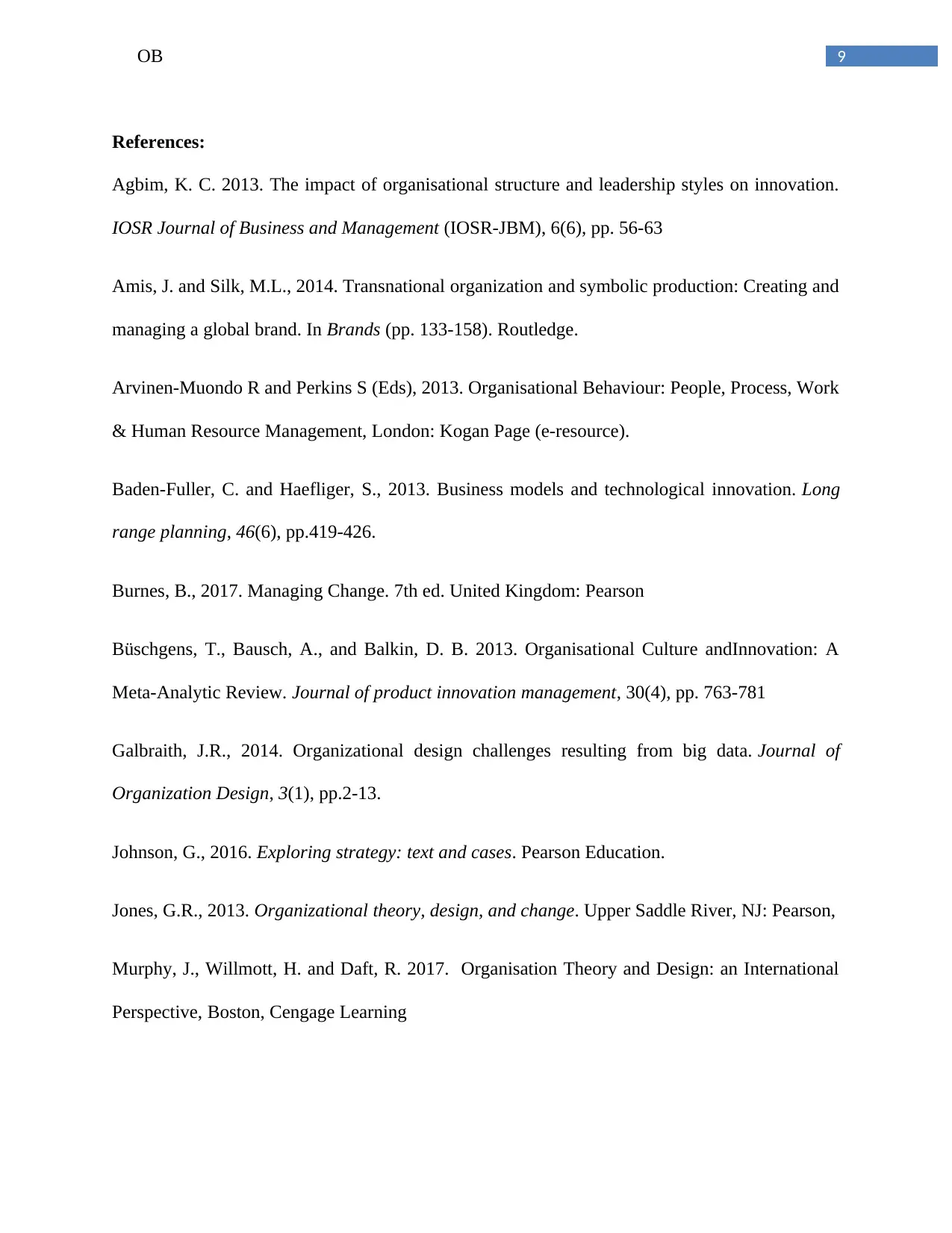
9OB
References:
Agbim, K. C. 2013. The impact of organisational structure and leadership styles on innovation.
IOSR Journal of Business and Management (IOSR-JBM), 6(6), pp. 56-63
Amis, J. and Silk, M.L., 2014. Transnational organization and symbolic production: Creating and
managing a global brand. In Brands (pp. 133-158). Routledge.
Arvinen-Muondo R and Perkins S (Eds), 2013. Organisational Behaviour: People, Process, Work
& Human Resource Management, London: Kogan Page (e-resource).
Baden-Fuller, C. and Haefliger, S., 2013. Business models and technological innovation. Long
range planning, 46(6), pp.419-426.
Burnes, B., 2017. Managing Change. 7th ed. United Kingdom: Pearson
Büschgens, T., Bausch, A., and Balkin, D. B. 2013. Organisational Culture andInnovation: A
Meta‐Analytic Review. Journal of product innovation management, 30(4), pp. 763-781
Galbraith, J.R., 2014. Organizational design challenges resulting from big data. Journal of
Organization Design, 3(1), pp.2-13.
Johnson, G., 2016. Exploring strategy: text and cases. Pearson Education.
Jones, G.R., 2013. Organizational theory, design, and change. Upper Saddle River, NJ: Pearson,
Murphy, J., Willmott, H. and Daft, R. 2017. Organisation Theory and Design: an International
Perspective, Boston, Cengage Learning
References:
Agbim, K. C. 2013. The impact of organisational structure and leadership styles on innovation.
IOSR Journal of Business and Management (IOSR-JBM), 6(6), pp. 56-63
Amis, J. and Silk, M.L., 2014. Transnational organization and symbolic production: Creating and
managing a global brand. In Brands (pp. 133-158). Routledge.
Arvinen-Muondo R and Perkins S (Eds), 2013. Organisational Behaviour: People, Process, Work
& Human Resource Management, London: Kogan Page (e-resource).
Baden-Fuller, C. and Haefliger, S., 2013. Business models and technological innovation. Long
range planning, 46(6), pp.419-426.
Burnes, B., 2017. Managing Change. 7th ed. United Kingdom: Pearson
Büschgens, T., Bausch, A., and Balkin, D. B. 2013. Organisational Culture andInnovation: A
Meta‐Analytic Review. Journal of product innovation management, 30(4), pp. 763-781
Galbraith, J.R., 2014. Organizational design challenges resulting from big data. Journal of
Organization Design, 3(1), pp.2-13.
Johnson, G., 2016. Exploring strategy: text and cases. Pearson Education.
Jones, G.R., 2013. Organizational theory, design, and change. Upper Saddle River, NJ: Pearson,
Murphy, J., Willmott, H. and Daft, R. 2017. Organisation Theory and Design: an International
Perspective, Boston, Cengage Learning
Paraphrase This Document
Need a fresh take? Get an instant paraphrase of this document with our AI Paraphraser

10OB
Nathaniel, S, 2018.Google’s Organizational Culture & Its Characteristics (An Analysis).
[Online]. Available at panmore.com http://panmore.com/google-organizational-culture-
characteristics-analysis[ accessed Mar 6, 2018]
Pattnaik, M., 2013. Skilled manpower selection for micro, small and medium enterprises: A
fuzzy decision making approach. Oper. and Sup. Ch. Mgmt, 6(2), pp.64-74.
Real, J.C., Roldán, J.L. and Leal, A., 2014. From entrepreneurial orientation and learning
orientation to business performance: analysing the mediating role of organizational learning and
the moderating effects of organizational size. British Journal of Management, 25(2), pp.186-208.
Schmidt, E. and Rosenberg, J., 2014. How google works. Hachette UK.
Steiber, A. and Alänge, S., 2013. A corporate system for continuous innovation: the case of
Google Inc. European Journal of Innovation Management.
Wilson F.M. (2010) Organisational Behaviour and Work: a Critical Introduction, Oxford: Oxford
University Press
Nathaniel, S, 2018.Google’s Organizational Culture & Its Characteristics (An Analysis).
[Online]. Available at panmore.com http://panmore.com/google-organizational-culture-
characteristics-analysis[ accessed Mar 6, 2018]
Pattnaik, M., 2013. Skilled manpower selection for micro, small and medium enterprises: A
fuzzy decision making approach. Oper. and Sup. Ch. Mgmt, 6(2), pp.64-74.
Real, J.C., Roldán, J.L. and Leal, A., 2014. From entrepreneurial orientation and learning
orientation to business performance: analysing the mediating role of organizational learning and
the moderating effects of organizational size. British Journal of Management, 25(2), pp.186-208.
Schmidt, E. and Rosenberg, J., 2014. How google works. Hachette UK.
Steiber, A. and Alänge, S., 2013. A corporate system for continuous innovation: the case of
Google Inc. European Journal of Innovation Management.
Wilson F.M. (2010) Organisational Behaviour and Work: a Critical Introduction, Oxford: Oxford
University Press
1 out of 11
Related Documents
Your All-in-One AI-Powered Toolkit for Academic Success.
+13062052269
info@desklib.com
Available 24*7 on WhatsApp / Email
![[object Object]](/_next/static/media/star-bottom.7253800d.svg)
Unlock your academic potential
Copyright © 2020–2025 A2Z Services. All Rights Reserved. Developed and managed by ZUCOL.





